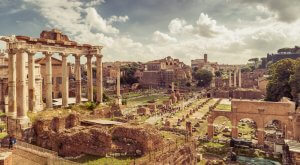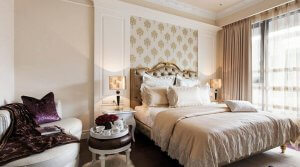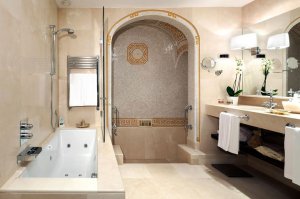What Was Interior Decor Like In the Roman Era?

The age of the Roman Empire was a time of great urban development. Homes became more comfortable and sophisticated, and people developed a new-found taste for fine art. But do you know what interior decor was like in the Roman era?
Needless to say, cities have evolved beyond recognition since then. But it was around this time that people developed many of the architectural techniques that we still use today, including things such as layout.
The ancient Romans had a particular affinity for aesthetics. They had huge reception rooms for guests where they would hold banquets and discuss business affairs. As such, the domus became a primary reference point for interior design.
Historical context

Before we look at the interior decor in more detail, we should probably start by giving you a brief historical overview of this fascinating period. Although the Roman Empire was founded back in the 1st Century BC, it wasn’t until the 3rd Century BC that architecture interior decor truly began to evolve.
They began to construct great cities, filling them with buildings known as insulae. These apartment buildings were where most of the urban, middle-class population lived. Archaeologists studying the remains of these insulae have found evidence of the importance of interior decor even here.
However, the greatest advances in interior design took place in Roman palaces and villas, where the wealthy would decorate with luxury items. They even painted their walls with elaborate murals, although this did not come into fashion until the 1st Century AD.
The Roman Empire left behind a historical and artistic legacy like no other.
Structural decor in the Roman era
Ancient Roman interior design was extremely varied. The style and aesthetic of each home depended entirely on the owner’s taste, although responsibility for decorating often fell to women.
- Rooms were usually large and spacious, and thus required a number of different decorative elements.
- The Romans often painted their walls with intricate designs, featuring anything from geometric patterns to scenes from Roman mythology. We know all this thanks to wall fragments retrieved from the rubble of the ancient Roman city of Pompeii. Red was also a popular choice for walls.
- Roman floors were true works of art, often featuring intricate mosaics. They used colored tiles to create different scenes, from animals and people to geometric patterns and symbols.
- Roofs were usually made of wood, although experts haven’t discounted the theory that they might also have used vaulted ceilings. They used a series of exposed beams, which were often painted and decorated.

Roman era furniture
When it came to the furniture, wood was the material of choice. The Ancient Romans were master carvers, using advanced techniques that allowed them to create original, and high-quality wooden furniture.
- Chests and wardrobes were a common feature in Roman homes.
- The triclinium was one of the most popular pieces of furniture in Ancient Roman times. Usually found in bedrooms and meeting rooms, the triclinium was similar to the modern chaise longue. They were usually furnished with brightly colored cushions, giving people a place where they could lie back and relax.
- Oil lamps: usually made of gold plated metal, oil lamps were designed to brighten and decorate Roman homes. Using bright tones such as gold and silver was a popular trend in Ancient Rome.
- The scriptorium was a type of study, with a simple table where the patronus could do his work. They would often decorate the scriptorium with elements such as amulets, figurines, and candelabras.
Additional decorative elements

The Romans used a number of other decorative elements to give their homes a more attractive and “imperial” look. Because their homes were so large and spacious, they would use these elements everywhere, from bedrooms to hallways.
- Sculptures: this is undoubtedly one of the most popular artistic techniques of the Roman era. Wealthy nobles would often obtain busts of themselves to display in their home. They would also decorate with sculptures of gods and emperors.
- Bowls, vases, and plates: many of these objects were available in local markets, while others were brought back from foreign lands (usually those conquered by the Romans).
- Fountains: water held great significance for the Ancient Romans, and they often had fountains in their homes.
The age of the Roman Empire was a time of great urban development. Homes became more comfortable and sophisticated, and people developed a new-found taste for fine art. But do you know what interior decor was like in the Roman era?
Needless to say, cities have evolved beyond recognition since then. But it was around this time that people developed many of the architectural techniques that we still use today, including things such as layout.
The ancient Romans had a particular affinity for aesthetics. They had huge reception rooms for guests where they would hold banquets and discuss business affairs. As such, the domus became a primary reference point for interior design.
Historical context

Before we look at the interior decor in more detail, we should probably start by giving you a brief historical overview of this fascinating period. Although the Roman Empire was founded back in the 1st Century BC, it wasn’t until the 3rd Century BC that architecture interior decor truly began to evolve.
They began to construct great cities, filling them with buildings known as insulae. These apartment buildings were where most of the urban, middle-class population lived. Archaeologists studying the remains of these insulae have found evidence of the importance of interior decor even here.
However, the greatest advances in interior design took place in Roman palaces and villas, where the wealthy would decorate with luxury items. They even painted their walls with elaborate murals, although this did not come into fashion until the 1st Century AD.
The Roman Empire left behind a historical and artistic legacy like no other.
Structural decor in the Roman era
Ancient Roman interior design was extremely varied. The style and aesthetic of each home depended entirely on the owner’s taste, although responsibility for decorating often fell to women.
- Rooms were usually large and spacious, and thus required a number of different decorative elements.
- The Romans often painted their walls with intricate designs, featuring anything from geometric patterns to scenes from Roman mythology. We know all this thanks to wall fragments retrieved from the rubble of the ancient Roman city of Pompeii. Red was also a popular choice for walls.
- Roman floors were true works of art, often featuring intricate mosaics. They used colored tiles to create different scenes, from animals and people to geometric patterns and symbols.
- Roofs were usually made of wood, although experts haven’t discounted the theory that they might also have used vaulted ceilings. They used a series of exposed beams, which were often painted and decorated.

Roman era furniture
When it came to the furniture, wood was the material of choice. The Ancient Romans were master carvers, using advanced techniques that allowed them to create original, and high-quality wooden furniture.
- Chests and wardrobes were a common feature in Roman homes.
- The triclinium was one of the most popular pieces of furniture in Ancient Roman times. Usually found in bedrooms and meeting rooms, the triclinium was similar to the modern chaise longue. They were usually furnished with brightly colored cushions, giving people a place where they could lie back and relax.
- Oil lamps: usually made of gold plated metal, oil lamps were designed to brighten and decorate Roman homes. Using bright tones such as gold and silver was a popular trend in Ancient Rome.
- The scriptorium was a type of study, with a simple table where the patronus could do his work. They would often decorate the scriptorium with elements such as amulets, figurines, and candelabras.
Additional decorative elements

The Romans used a number of other decorative elements to give their homes a more attractive and “imperial” look. Because their homes were so large and spacious, they would use these elements everywhere, from bedrooms to hallways.
- Sculptures: this is undoubtedly one of the most popular artistic techniques of the Roman era. Wealthy nobles would often obtain busts of themselves to display in their home. They would also decorate with sculptures of gods and emperors.
- Bowls, vases, and plates: many of these objects were available in local markets, while others were brought back from foreign lands (usually those conquered by the Romans).
- Fountains: water held great significance for the Ancient Romans, and they often had fountains in their homes.
All cited sources were thoroughly reviewed by our team to ensure their quality, reliability, currency, and validity. The bibliography of this article was considered reliable and of academic or scientific accuracy.
Bianchi-Bandinelli, R.; Torelli, M.: El arte de la antigüedad clásica, Akal, 2000.
Jenkins, Ian: La vida cotidiana en Grecia y Roma, Akal, 1997.







